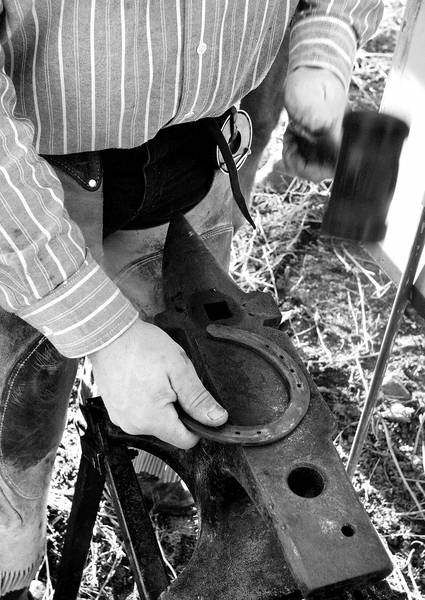The work of a farrier
Published 4:00 am Monday, February 12, 2007

- Greg Groce uses a hammer and anvil to shape a shoe before shoeing a horse at the Sisters View Ranch last month.
TUMALO – Central Oregon’s smaller ranches and the appearance of backyard or ”hobby farms” have led to a growing horse population and more demand for horseshoeing services, industry and agricultural officials say.
Business is ”hot” in Central Oregon because of all the horse people moving to the region, said Beau Whitaker, a former Madras resident who owns and operates both the Oregon Farrier School in Salem and West Coast Farriers in Central Oregon.
Farriers are used for maintaining horses’ hooves and shaping horseshoes specifically to hooves to promote maximum performance and health. They’re skilled blacksmiths whose tools include farrier chaps, a driving hammer, nail cutters and hoof stand.
Their services are in demand.
Between 1997 and 2002, the number of farms in Deschutes and Crook counties increased 9 percent, from 2,119 to 2,317, according to U.S. Department of Agriculture census data.
Meanwhile, the average farm size in Crook County decreased 10 percent, from 1,518 acres to 1,369 acres. In Deschutes County, the average farm size decreased 1 percent, from 86 acres to 85 acres, according to census data.
”There are more small farms and a lot of people moving here who want to buy a piece of the rural countryside,” said Mylen Bohle, an agronomist with Oregon State University. ”There’s a huge demand for 1- to 10-acre parcels, where you can have a horse or two and other livestock.”
Statewide, the number of horses increased from 117,200 to 127,400 from 2000 to 2006, said Barbi Riggs, a livestock agent for Oregon State University.
”Along with the declining farm sizes and increasing appearance of hobby farms there is an increasing horse population,” she wrote in an e-mail. ”These horses are housed on small paddocks or stables. Limited exercise and wear on the hoof requires more frequent trimming and additional daily care from the owners.”
Most importantly, farriers need a willing horse, said Greg Groce, owner of West Coast Farriers, who recently completed a 10-week certification course at the Oregon Farriers School in Salem.
”I’ve been around horses since my youth,” said Groce, who had five years of horseshoeing experience and grew up on a family farm near Maupin. ”But I wanted to learn to do it right.”
Professional farriers use specialized knowledge and skills to shoe a horse, including forging, horse psychology and anatomy, Groce said.
”Farriers are the first stop for horses before they go off to the vet,” Groce said. ”If I do it right, he’s fixed and walking off sound.”
Horseshoeing has both benefits and risks, said Leslie Gill, an equine practitioner in the region for more than 30 years.
”Shoeing can protect the foot both mechanically by balancing the foot, and medically for treating both abscess or fracture,” Gill said. ”But poor shoeing can lead to all kinds of problems,” including a contracted heel, disease and lameness.
A typical farrier charges between $80 and $95 for shoeing a horse, $30 for a trim and between $35 and $40 for a trim-and-pull, Whitaker said.
A trim involves taking off the rough edges or shortening a horse’s hoof so that it becomes square to the horse’s body and creates balance for the horse.
The trim-and-pull includes removing the horseshoe and letting the horse go shoeless during the winter, he said.
”Farriers are essential for taking care of horses’ feet,” Whitaker said. ”It’s like wearing a pair of shoes. If they’re uneven, it could damage the whole leg.”
But skilled farriers are hard to find, said Bill Searle, who has worked in the area for more than 30 years.
He’s seen an increase in the number and quality of horses he works on and a greater need for farriers.
”There are better-quality farriers moving into the region,” Searle said.
But it’s an unregulated industry and some farriers don’t measure up, he said.
Larry Davis, a 77-year-old farrier who has worked in the trade since 1942, said most customers don’t know how to correctly evaluate high-quality work.
”We’re an independent bunch of hardheads, including myself,” Davis said. ”If we weren’t that way, we wouldn’t be doing this.”
Davis said horse owners should become more aware of proper trimming and fitting techniques so they can recognize those skills in a farrier.
”Horseshoers get busy and careless,” Davis said. ”The horse owner really needs to sit down and talk with the farrier about their horse’s feet.”
Sharon Studdard, owner of Rakkan Equestrian Center in Bend, said good farriers need to be able to communicate well with the customer, horse and veterinarian.
”There’s a farrier on every corner, but whether they’re good or not remains to be seen,” Studdard said. ”They need to work for a number of years before they know how to handle different issues.”






